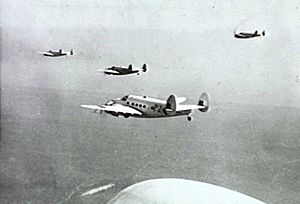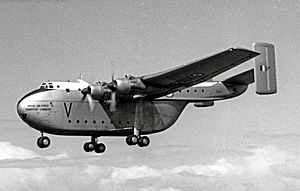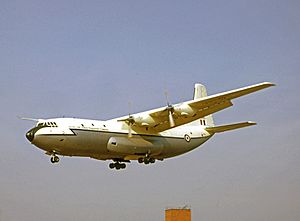No. 53 Squadron RAF facts for kids
Quick facts for kids No. 53 Squadron |
|
|---|---|
| Active | 15 May 1916–25 October 1919 28 June 1937 – 15 June 1946 1 November 1946 – 28 June 1963 1 November 1965 - 14 September 1976 |
| Country | |
| Branch | |
| Motto(s) | United in effort |
| Battle honours | Western Front, 1916-18*: Messines, 1917*: Ypres, 1917*: France & Low Countries, 1939-40: Dunkirk*: Invasion Ports, 1940: Channel & North Sea, 1940-44: Fortress Europe, 1940- 41*: Biscay Ports, 1941-42*: Biscay 1941-44:Atlantic 1941-45*: Normandy 1944*:Honours marked with an asterisk are those emblazoned on the Squadron Standard |
| Insignia | |
| Squadron badge heraldry | In front of a saltire, a thistle slipped and leaved. |
| Squadron codes | TE Jan 1939 - Sep 1939 PZ Sep 1939 - Feb 1943 FH Jun 1944 - Feb 1946 PU Dec 1946 -Jul 1949 (Codes taken over from No 187 Sqn) |
No. 53 Squadron was a special group of pilots and planes in the Royal Air Force (RAF). They flew missions during both the First World War and the Second World War. This squadron was known for its important work in reconnaissance and transport.
Contents
History of No. 53 Squadron
Early Years and World War I Missions
No. 53 Squadron first started on 15 May 1916 at RAF Catterick. It was part of the Royal Flying Corps, which was the air force before the RAF. The squadron was first meant to train pilots. However, by December 1916, it was sent to France. There, its job was to fly reconnaissance missions. This means they would fly over enemy areas to gather information.
The squadron first used planes called the B.E.2e. Later, in April 1917, they switched to the R.E.8. After the war ended, the squadron returned to the UK. It was officially closed down on 25 October 1919.
Reforming for World War II
The squadron was brought back to life on 28 June 1937. This happened at RAF Farnborough. Their new role was to help the Army, especially with night reconnaissance. They used Hawker Hector planes for this.
In January 1939, they received Bristol Blenheim light bomber planes. Soon after, in September, they moved to France. When Germany attacked France in May 1940, the squadron had to return to the UK. From there, they continued to fly bombing and reconnaissance missions.
Coastal Command and Anti-Submarine Patrols
In 1940, No. 53 Squadron changed roles again. They joined RAF Coastal Command. This meant their new job was to protect ships and hunt for enemy submarines. They moved to RAF St Eval in Cornwall for these operations.
In July 1941, their Blenheim planes were replaced by Lockheed Hudson aircraft. These were better for long patrols over the sea. The squadron even moved to the Eastern Seaboard of the USA in July 1942. From there, they went to Trinidad in the Caribbean.
Later, they returned to Cornwall and received Armstrong Whitworth Whitley planes in early 1943. By May, they were flying large Consolidated Liberator planes from RAF Thorney Island. These planes were very good for long-range patrols over the Atlantic Ocean.
Post-War Transport and Final Years
In September 1944, the squadron moved to Iceland. They stayed there until the end of the war in Europe. After the war, they returned to the UK. No. 53 Squadron then joined RAF Transport Command. Their new job was to fly troops to India. The squadron was closed down again on 15 June 1946.
But No. 53 Squadron didn't stay closed for long! It reformed on 1 November 1946. This time, they flew Douglas Dakotas. These planes were used to help with the Berlin Airlift. This was a huge effort to fly supplies into Berlin when the city was blocked. After this important work, the squadron was disbanded on 31 July 1949.
The very next day, the squadron reformed again! This was on 1 August 1949 at RAF Topcliffe. They used Handley Page Hastings transport planes. In 1957, these were replaced by Blackburn Beverley aircraft. The squadron was disbanded once more on 28 June 1963.
On 1 November 1965, No. 53 Squadron reformed at RAF Fairford. They became the RAF's first and only squadron to fly the large Short Belfast transport plane. They moved to RAF Brize Norton in 1967. The squadron continued to operate these huge planes until it was finally disbanded on 14 September 1976.
See also
- List of Royal Air Force aircraft squadrons
- 1957 Sutton Wick Beverley accident




